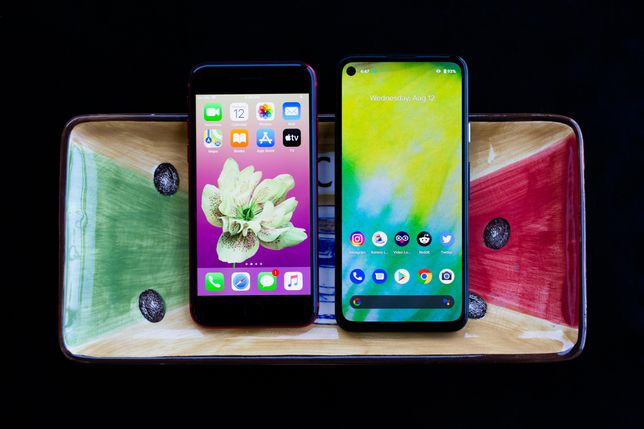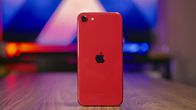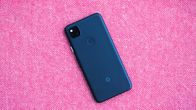This has been an abundant year for wallet-friendly phones with impressive performance and specs. Apple and Google, for example, launched smaller versions of their marquee handsets and the iPhone SE and the Pixel 4A are affordable alternatives to the iPhone 11 and Pixel 4, respectively. Both phones are $400 or under. The iPhone starts at $399 (£419, AU$749) while the Pixel 4A costs $349 (£349, AU$599). Their single 12-megapixel cameras also take brilliant photos and with iOS 14 and Android 11 coming down the pipeline, their software promises to remain fresh and up-to-date.
To see which phone is the better fit for you, I compare them in terms of camera, design, software, performance and battery. In short, the iPhone SE is the faster, more polished phone. But the Pixel 4A’s cheaper price tag, longer-lasting battery and nimble camera make it the better value buy.
Read more: Best iPhone charger for 2020
Angela Lang/CNET
Though it’s the cheapest iPhone you can get new, the iPhone SE offers a lot of what the premium iPhones also have. That includes the powerful and fast A13 Bionic processor, a water-resistant design, wireless charging and Wi-Fi 6. Its superb camera also records excellent video. At $400 it’s a bit more expensive than the Pixel 4A, but it’s still relatively affordable as far as phones go, and especially as far as iPhones go.
Read our Apple iPhone SE (2020) review.
Angela Lang/CNET
This makes more compromises than the iPhone SE and it has fewer features than its bigger brother, the Pixel 4. It doesn’t have wireless charging or water-resistance, for instance, and it has the less powerful Snapdragon 730G processor. But its enduring battery life outlasts the iPhone SE and its exceptional camera is the same as the main camera on the Pixel 4. Lastly, when you consider storage and compare the Pixel 4A to the 128GB model of the iPhone SE, the $50 price difference jumps to $100.
iPhone SE’s camera has superior video, but Pixel 4A is fantastic in low light
For a complete rundown on how these two phones fare in terms of camera and video, head over to CNET editor Lexy Savvides’ iPhone SE vs. Pixel 4A camera comparison and watch the video below.
In short, the camera you like best depends on what kind of photos you often take and what kind of situations you find yourself in. If you love to capture moments with your friends while out and about at all times of the day, the Pixel 4A and its superb Night Mode may be the better choice. If you take tons of video and selfies, go for the iPhone SE.
I’ll give Savvides the last word: “The Pixel 4A is clearly better for low-light photography and as a result is stronger overall for still images. It also has more options than the iPhone SE in its default camera app. The iPhone SE has the edge for video and selfies.”
iPhone SE’s elegant build outshines Pixel 4A’s design and sharper display
As they’re making budget versions of their flagship counterparts, it would make sense if Apple and Google skimped on a few design details to cut down costs. But the quality of the iPhone SE’s design is similar to current iPhones. While it does have thicker bezels than new iPhones to accommodate the front-facing camera and physical home button, the iPhone SE retains the glossy glass encasing and water-resistant body. It also comes in three colors: black, white and red.
The Pixel 4A, on the other hand, doesn’t look as elegant. It only comes in one color (black), and besides its baby-blue power button, its matte polycarbonate body looks drab. Its overall build feels cheaper, it isn’t water-resistant and its single camera bump on the back is much larger than the iPhone’s rear camera.
One thing I do like about the Pixel 4A’s design, however, is its OLED screen. Though both phones have fine displays that are good for viewing videos and playing games, the Pixel 4A’s display is a tad sharper; it has a 1080p resolution (compared to the iPhone SE’s 750p resolution) and a higher pixel density. Its thinner bezels and hole-punch front-facing camera also look more modern compared to the iPhone SE’s “throwback” look to 2017.
Comparison of iOS and Android smartphone UI
When comparing Apple and Google phones running iOS and Android, respectively, only you can decide which OS works best for you and what ecosystem you’re already comfortable with. Both phones have built-in digital search assistants (Siri and Google Assistant), digital payment systems (Apple Pay and Google Pay) and smaller goodies like dark mode and digital wellbeing tools to curb screen-viewing time. And more recently, Android phones have added their own version of Apple’s AirDrop, which means both phones can transfer files to other phones (that are on their respective OS platforms) within a short distance.
The Pixel 4A has a few software features that the iPhone doesn’t have. One is native transcribing capabilities. In addition to transcribing audio recordings and captioning videos in real time, the Pixel 4A can transcribe phone calls, including ones made via third-party apps such as Facebook Messenger. The phone also has Call Screen, which screens robocalls and telemarketers as well as crash detection, which automatically calls preprogrammed emergency contacts when the phone senses a car crash. The upcoming Android 11 update, which is in public beta now, offers built-in screen recording, chat bubbles for the Message app and quick controls.
The iPhone SE has a few unique software and UX things of its own too. One is a physical home button, which means you don’t need to use swiping gestures to navigate around the phone. Apple’s upcoming iOS 14, which will be compatible with the iPhone SE, promises an App Library to organize apps on the homescreen and a handful of features already familiar to Android users including a built-in translation app, widgets and picture-in-picture.
iPhone SE performs better, but Pixel 4A has a longer lasting battery
In general, the Pixel 4A and its Snapdragon 730G chipset are fast and reliable. However, there were a few times when I ran into some small snags. After I downloaded Call of Duty and PUBG, for example, I had to restart the phone because both apps stalled while loading. And every once in a while when I was reviewing the phone, an app would unexpectedly quit or I had to relaunch the camera because the on-screen shutter button wouldn’t register.
I never noticed such hiccups during my time with the iPhone SE. In addition, the iPhone SE’s proprietary A13 Bionic comfortably beat the Pixel 4A on all our standard benchmark tests, which include 3DMark and Geekbench 5.0.
3DMark Slingshot Unlimited
Note:
Longer bars indicate better performance
3DMark Ice Storm Unlimited
Note:
Longer bars indicate better performance
Geekbench v.5.0 single-core
Note:
Longer bars indicate better performance
Geekbench v.5.0 multicore
Note:
Longer bars indicate better performance
When it comes to battery tests for continuous video playback on Airplane mode, however, the Pixel 4A won that round. Even with Google’s Adaptive Battery feature turned off, the Pixel 4A outlasted the iPhone SE and averaged 18 hours, 45 minutes, which is an excellent time. In turn, the iPhone SE clocked in about 15 hours, 45 minutes. That’s still a respectable time but it’s still three hours shorter than the Pixel 4A. We’re still undergoing more battery tests with streaming video for both phones and I’ll update this piece when those numbers come in.
Other budget smartphone features to consider
Both phones have dual-SIM. In addition to your regular nano-SIM, both phones use e-SIM technology that supports multiple phone numbers. This is useful if you travel often, or want to keep two numbers (say your personal and work) on the same device.
The iPhone SE has Wi-Fi 6. Though Wi-Fi 6 was only certified in September 2019 and routers featuring the next-gen network remain expensive, the fact that the iPhone SE has Wi-Fi 6 means it’s ready for the future. Devices with Wi-Fi 6 speak that same Wi-Fi language to talk to each other. Compared to Wi-Fi 5, it’s faster and more battery efficient.

The iPhone SE (left) and the Pixel 4A.
Angela Lang/CNET
Neither phone has expandable storage. The Pixel 4A has one memory option: 128GB with 6GB of RAM. This is double the amount of storage compared to last year when the Pixel 4 started with only 64GB. The iPhone SE, in contrast, has three: 64GB, 128GB and 256GB. When strictly comparing 128GB models of both phones then, the iPhone SE’s price difference is even higher: The 128GB model of the iPhone SE costs $449 (£469, AU$829) compared with the $349 (£349, AU$599) Pixel 4A.
If you want more storage, Apple’s iCloud gives you 5GB for free and it costs $10 a month for 2TB. Google, on the other hand, allows Pixel users to upload unlimited photos and video at “high” quality, which is of lower resolution and less detail than “original” quality. If you want the latter, you’ll need to sign up for Google’s One service. Google One is free for the first 15GB, but also costs $10 a month for 2TB.
Comparison of iPhone SE vs. Pixel 4A
| Apple iPhone SE (2020) | Google Pixel 4A | |
| Display size, resolution | 4.7-inch LCD; 1,334×750 pixels | 5.81-inch OLED; 2,340×1,080 pixels |
| Pixel density | 326ppi | 443ppi |
| Dimensions (Inches) | 5.45×2.65×0.29 in | 5.7×2.7×0.3 in |
| Dimensions (Millimeters) | 138.4×67.3×7.3 mm | 144×69.4×8.2 mm |
| Weight (Ounces, Grams) | 5.22 oz; 148g | 5.04 oz; 143g |
| Mobile software | iOS 13 | Android 10 |
| Camera | 12-megapixel | 12.2-megapixel |
| Front-facing camera | 7-megapixel | 8-megapixel |
| Video capture | 4K | 4K |
| Processor | Apple A13 Bionic | Qualcomm Snapdragon 730G |
| Storage | 64GB, 128GB, 256GB | 128GB |
| RAM | Not disclosed | 6GB |
| Expandable storage | No | No |
| Battery | Not disclosed, but Apple claims it has the same battery life as iPhone 8 | 3,140 mAh |
| Fingerprint sensor | Home button | Back |
| Connector | Lightning | USB-C |
| Headphone jack | No | Yes |
| Special features | Water-resistant (IP67); dual-SIM capabilities (nano-SIM and e-SIM); wireless charging | Dual-SIM capabilities (nano-SIM and e-SIM) |
| Price off-contract (USD) | $399 (64GB), $449 (128GB), $549 (256GB) | $349 |
| Price (GBP) | £419 (64GB), £469 (128GB), £569 (256GB) | £349 |
| Price (AUD) | AU$749 (64GB), AU$829 (128GB), AU$999 (256GB) | AU$599 |









More Stories
Allegations of corruption Qatar warns of ‘negative impact’ of European measures
USA: Famous “Hollywood cat” euthanized in Los Angeles
The campaigner who called for the shooting of Ukrainian children has not been charged